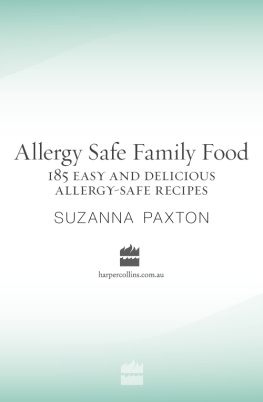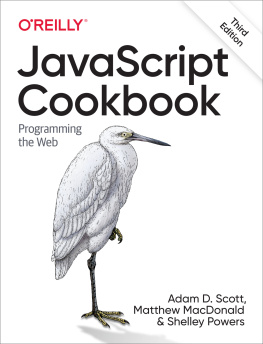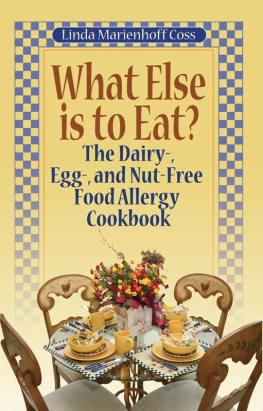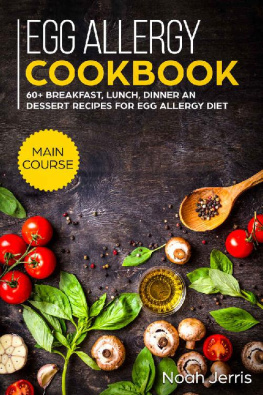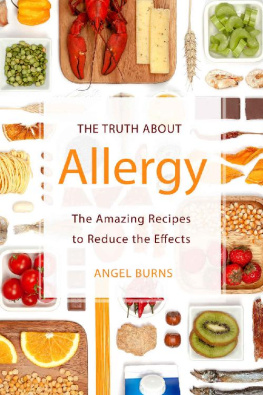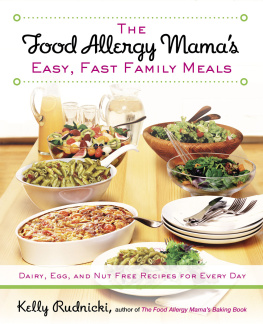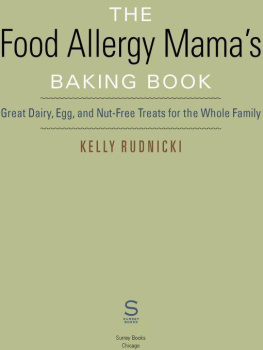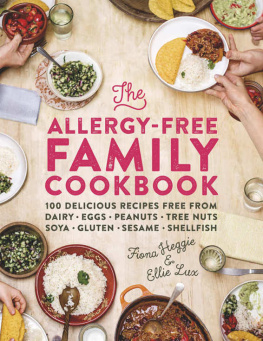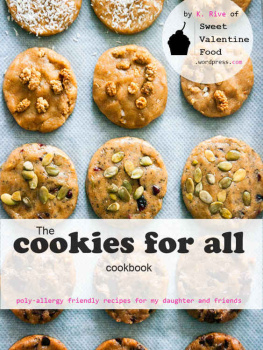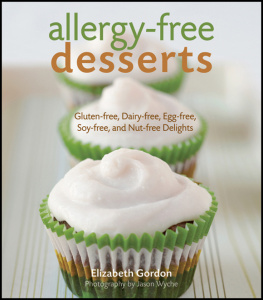Paxton - Allergy safe family food: 185 easy and delicious allergy-safe recipes
Here you can read online Paxton - Allergy safe family food: 185 easy and delicious allergy-safe recipes full text of the book (entire story) in english for free. Download pdf and epub, get meaning, cover and reviews about this ebook. City: Enfield;Pymble;N.S.W, year: 2009, publisher: HarperCollins (Australia), Publishers Group UK [distributor], genre: Home and family. Description of the work, (preface) as well as reviews are available. Best literature library LitArk.com created for fans of good reading and offers a wide selection of genres:
Romance novel
Science fiction
Adventure
Detective
Science
History
Home and family
Prose
Art
Politics
Computer
Non-fiction
Religion
Business
Children
Humor
Choose a favorite category and find really read worthwhile books. Enjoy immersion in the world of imagination, feel the emotions of the characters or learn something new for yourself, make an fascinating discovery.
- Book:Allergy safe family food: 185 easy and delicious allergy-safe recipes
- Author:
- Publisher:HarperCollins (Australia), Publishers Group UK [distributor]
- Genre:
- Year:2009
- City:Enfield;Pymble;N.S.W
- Rating:5 / 5
- Favourites:Add to favourites
- Your mark:
- 100
- 1
- 2
- 3
- 4
- 5
Allergy safe family food: 185 easy and delicious allergy-safe recipes: summary, description and annotation
We offer to read an annotation, description, summary or preface (depends on what the author of the book "Allergy safe family food: 185 easy and delicious allergy-safe recipes" wrote himself). If you haven't found the necessary information about the book — write in the comments, we will try to find it.
Paxton: author's other books
Who wrote Allergy safe family food: 185 easy and delicious allergy-safe recipes? Find out the surname, the name of the author of the book and a list of all author's works by series.
Allergy safe family food: 185 easy and delicious allergy-safe recipes — read online for free the complete book (whole text) full work
Below is the text of the book, divided by pages. System saving the place of the last page read, allows you to conveniently read the book "Allergy safe family food: 185 easy and delicious allergy-safe recipes" online for free, without having to search again every time where you left off. Put a bookmark, and you can go to the page where you finished reading at any time.
Font size:
Interval:
Bookmark:
For Samuel and Emily
While the recipes and other information contained in this book are intended to assist children who suffer from food allergies to eat well and imaginatively while avoiding allergic reactions, this book is not in any way a substitute for medical advice regarding food allergies. It is essential that children who are diagnosed with such allergies (or are suspected as such) are under the regular care of a doctor or allergy specialist who will provide a specific allergy-management plan, including dietary advice. Furthermore, while every care is taken to provide accurate information, products often changewithout warning, and with no outward change to the appearance of the product. You must always read the ingredients list of all products. Please read the section About Food Allergies & About This Book on page 9.The pagination of this electronic edition does not match the edition from which it was created.
Food manufacturing processes and ingredients can changeand frequently do. For example, a thickener in a sauce may change; the new thickener may now contain soy where previously it was soy-free. Remember that many foods have alternative names (see pages 192 to 204 for more specific information).
Look for the May containor Contains warnings The manufacturer may choose to provide a warning on the label if there is the slightest chance that a product may have come into contact with an allergen. They are under no legal obligation to do so. Check with your doctor for guidance regarding your allergy risks. (Australasian Society of Clinical Immunology and Allergy, 2008) The incidence of food allergy continues to rise. (Australasian Society of Clinical Immunology and Allergy, 2008) The incidence of food allergy continues to rise.
All people with allergies should be under the supervision of an appropriately qualified medical practitioner or allergy specialist. It is important that they re-test: many children outgrow allergies. Gluten intolerance (coeliac disease) is never outgrown. Food intolerance, which does not involve the immune system, is a separate topic; it is beyond the scope of this book. The foods that commonly trigger allergic reactions are peanuts, tree nuts (almond, brazil nut, cashew, chestnut, hazelnut, macadamia, pecan, pistachio, walnut), egg, cows milk, soy, wheat, fish, shellfish and sesame seed. If someone is allergic to a specific food, when they come in contact with the protein associated with that food their bodys immune system overreacts, ie produces an allergic reaction.
Even a tiny amount of an allergen (the thing that triggers the allergic response) can cause a reaction. People with a food allergy must avoid all contact with that food. Only a doctor or allergist can diagnose food allergy. Allergic reactions range from mild, such as a runny nose, hives, rash or stomach pains, through to serious and even life-threatening symptoms, such as swelling of the tongue and throat, breathing difficulties and collapse. The most severe allergic reaction is called anaphylaxis, or an anaphylactic response. This means the symptoms are life-threatening.
The respiratory system (the lungs, airways and respiratory muscles) and/or cardiovascular system (the heart and blood vessels) are affected and the whole body starts to shut down. Prompt action must be taken. Children with severe food allergies (those who are at risk of anaphylaxis) typically carry an emergency bag or box with them; this contains their Anaphylaxis Action Plancompleted and signed by their doctorand emergency medication, including an EpiPen (a pre-loaded adrenaline injection). The Anaphylaxis Action Plan outlines the steps to follow if an anaphylactic reaction occurs.
- Do not leave the unwell person alone.
- Use the EpiPen (pre-loaded adrenaline injection) straight away.
- Do not leave the unwell person alone.
- Use the EpiPen (pre-loaded adrenaline injection) straight away.
Even if you are not 100% sure the reaction is anaphylaxis, use the EpiPen.
- Get urgent medical attention. CALL AN AMBULANCE by dialling 000 (mobile phone users should dial 012).
If an unsafe food brushes against a safe food, the so-called safe food has been contaminated. The riskiest place in your house for cross-contamination of food is the kitchen. That is why safe food preparation techniques are a must. The first principle for preventing cross-contamination is to identify the food allergen and either ensure it does not come into your home or else store it separately so it does not touch other food. Second, the person preparing food for the individual with the allergy must always wash their hands prior to preparing food and always use clean utensils and preparation boards. For example, eggs are a great source of protein, but our son Samuel is anaphylactic to egg, so we have to make sure no eggs or egg products touch him.
Say there was a plate of biscuits put in front of us, half containing eggs and the other half egg-free, we would never let Samuel eat anything from that plate. Even a crumb could set off a serious reaction. Instead we would keep the two types of biscuit completely separate from the start and place them on individual plates. Then we would explain to Sam which biscuits were safe for him. As a further example, we couldnt all sit around the breakfast table together with Samuel eating cereal and the rest of us eating scrambled eggs, either. If we really had to have eggs, Samuel would eat first.
Once he had left the table, the rest of us would then eat. Afterwards, we would thoroughly clean the cooking utensils, crockery, benches and table, then we would all brush our teeth and wash our hands and faces before touching Samuel. Fortunately, not all food allergies are this severe. It is important to understand the extent of your childs allergy so that you can avoid being unnecessarily restrictive, which can give rise to nutritional deficiencies. Proper dietary advice is essential.
Font size:
Interval:
Bookmark:
Similar books «Allergy safe family food: 185 easy and delicious allergy-safe recipes»
Look at similar books to Allergy safe family food: 185 easy and delicious allergy-safe recipes. We have selected literature similar in name and meaning in the hope of providing readers with more options to find new, interesting, not yet read works.
Discussion, reviews of the book Allergy safe family food: 185 easy and delicious allergy-safe recipes and just readers' own opinions. Leave your comments, write what you think about the work, its meaning or the main characters. Specify what exactly you liked and what you didn't like, and why you think so.

